THE PANEL「テクノロジーの進化。これからの音楽とファッション」
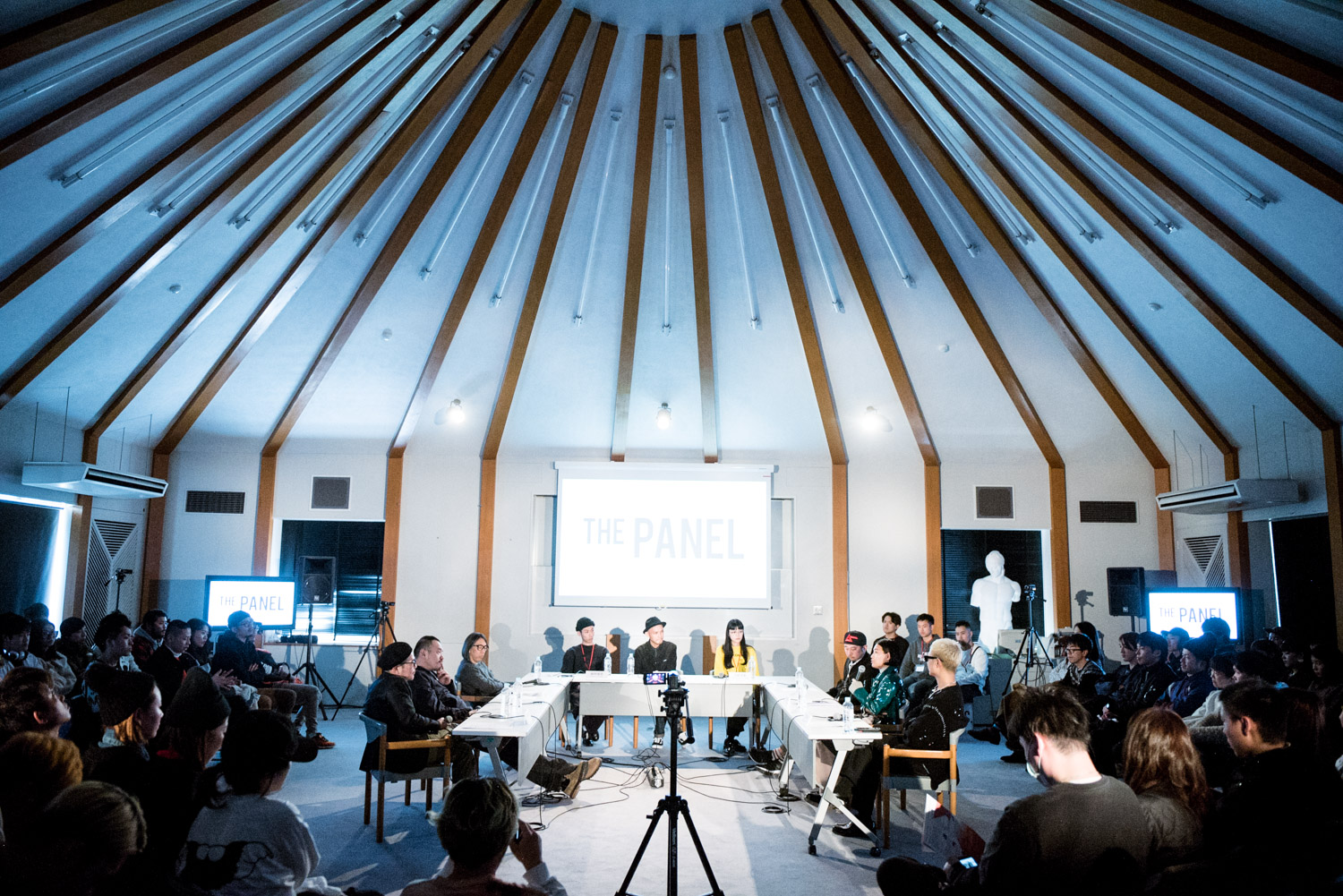
2月14日、京都精華大学にて、客員教授である藤原ヒロシとS.U.C.Cの学生たちが中心となってパネル・ディスカッションを開催した。同じく京都精華大学の非常勤講師を務める光嶋崇をコーディネーターとして、VERBAL、源馬大輔、鈴木哲也、中里周子、政田武史という豪華な顔ぶれに学生2人を交えて、計9人が登壇した。テーマは「テクノロジーの進化。これからの音楽とファッション」。テクノロジーが進化する中、クリエイティブであるとはどういうことなのか。クリエイションはどのように生き残っていくべきなのか。
Photo & Text : Shoichi KAJINO
パネリスト
藤原ヒロシ(Fragment Design主宰/ 京都精華大学ポピュラーカルチャー学部客員教授)
源馬大輔(クリエイティブ・ディレクター)
鈴木哲也(クリエイティブ・ディレクター/ 元 honeyee.com 編集長)
VERBAL (アーティスト、AMBUSH®クリエイティブディレクター、m-flo、PKCZ®、HONEST BOYZ®)
中里周子(ファッションデザイナー/ 東京藝術大学・大学院博士課程在籍)
政田武史(画家/ 京都精華大学ポピュラーカルチャー学部非常勤講師)
今田早紀(京都精華大学ポピュラーカルチャー学部在籍 *S.U.C.C.メンバー)
前田流星(イラストレーター/ バレーボウイズ *S.U.C.C.代表)
1. クリエイションはどこで生き残っていくのか
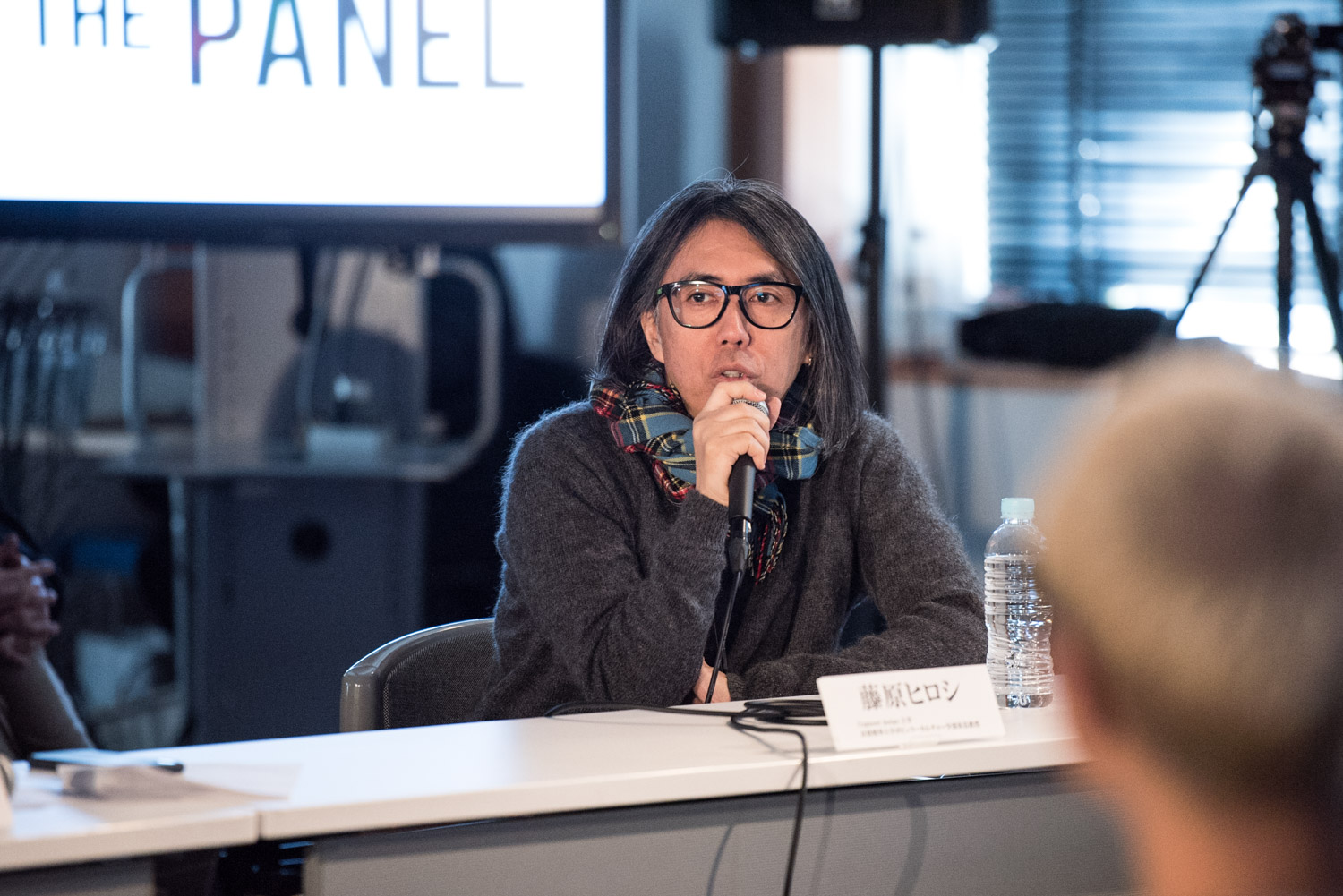 藤原ヒロシ:最近、テクノロジーの進化はどういうことか、と考えているんですが、よく言われることの一つは、ものを小さくすること、あるいは一つのものに機能を集結させていくことです。たとえば、電話が携帯、スマホになっていったみたいに。音楽もわかりやすい例だと思う。かつては、広場にみんなで集まって聴いていたものが、ある日30cmのレコードとしてジャケットに入って自宅に届くようになった。次は12cmのCDになって、アートワークも小さくなって、今やデジタルになって空(クラウド)から音楽だけがやってくる。たしかにテクノロジーのおかげで便利になって、いろいろな場所や仕方で音楽を楽しめるようになったと思う。けれど、レコードジャケットやアートワークがなくなったという点でみれば、クリエイティビティの退化とも言えるのでは、と思いはじめて。音楽だけでなくファッションもそういう状況に直面していると感じていて。だから、テクノロジーはクリエイティビティとどう結びついて行くのか、今日はそういうことについて話せればと思っています。
藤原ヒロシ:最近、テクノロジーの進化はどういうことか、と考えているんですが、よく言われることの一つは、ものを小さくすること、あるいは一つのものに機能を集結させていくことです。たとえば、電話が携帯、スマホになっていったみたいに。音楽もわかりやすい例だと思う。かつては、広場にみんなで集まって聴いていたものが、ある日30cmのレコードとしてジャケットに入って自宅に届くようになった。次は12cmのCDになって、アートワークも小さくなって、今やデジタルになって空(クラウド)から音楽だけがやってくる。たしかにテクノロジーのおかげで便利になって、いろいろな場所や仕方で音楽を楽しめるようになったと思う。けれど、レコードジャケットやアートワークがなくなったという点でみれば、クリエイティビティの退化とも言えるのでは、と思いはじめて。音楽だけでなくファッションもそういう状況に直面していると感じていて。だから、テクノロジーはクリエイティビティとどう結びついて行くのか、今日はそういうことについて話せればと思っています。
光嶋崇:アナログレコードをテクノロジーとして捉えていることは面白いですね。ファッションはどうでしょうか?
中里周子:テクノロジーの進化には、新しいものを生み出す可能性があるとしても、そもそもその言葉自体から、どこか古い印象も受けます。進歩だけでなく、そこにはオールドでギークな感じもある。科学技術館のプラズマボールのような。
鈴木哲也:テクノロジーという言葉にファンタジックな未来がセットになっていた時代があったと思うんです。SF映画やアニメに描かれた、テクノロジーと共にある生活が魅力的に映っていたというか。ただ、そのファンタジーとは違う方向に、今の生活は進んでいるのでは、ということだと思うんです。合理化、効率化がテクノロジーの発展してきた方向ですよね。音楽の配信がメインになってしまってパッケージがないから、そこに乗っかっていたクリエイティビティがなくなったりして、便利で合理的にということが、必ずしもクリエイティブとは思えない、ということですよね。その中でどうやってクリエイションが生き残っていくのか、それが今日のテーマなのかと思います。
源馬大輔:(テクノロジーの進化というのは)チョイスの一つが増えることだと思うんです。必ずしも新しいものが最高とは言い切れない。タンパク質から糸を作り出そうとするけど、糸の質感は(既存の)ベビーカシミヤを目指したり。例えば、僕はMP3がすごく嫌いで、クリエーションに対してビジネスが勝った瞬間と思えたからなんです。
藤原:でも君のiPhoneにはMP3いっぱいはいってるでしょ?
源馬:いえ、WAV(圧縮されていないフォーマット)で入ってます(笑)。常に1%でもクリエーションが勝っていたいという数少ない抵抗というか。
政田武史:自分の子供の頃はドラクエ3が最先端でした。当時のコンピューターゲームはピクセルの荒い画面だったわけですけど、ソフトのパッケージの(鳥山明の)ヴィジュアルを見て、頭の中で補完して楽しんでいたんです。でも今は、なんでもかんでもクリアに見せすぎていて、自分の「想像」の入る余地がなくなっていくのがさみしいかなと。
藤原:スノボウェアにBluetoothが取り付けられたことがあって、すごいと思ったけど、実際のところ、それはテクノロジーの進化の中で取り残されてしまってファッションの邪魔になってしまう。面白くても10年後には使えなくなってしまう。ガジェットとファッションは一緒になれない。
源馬:人間の感性はあまり変わらないということですかね。
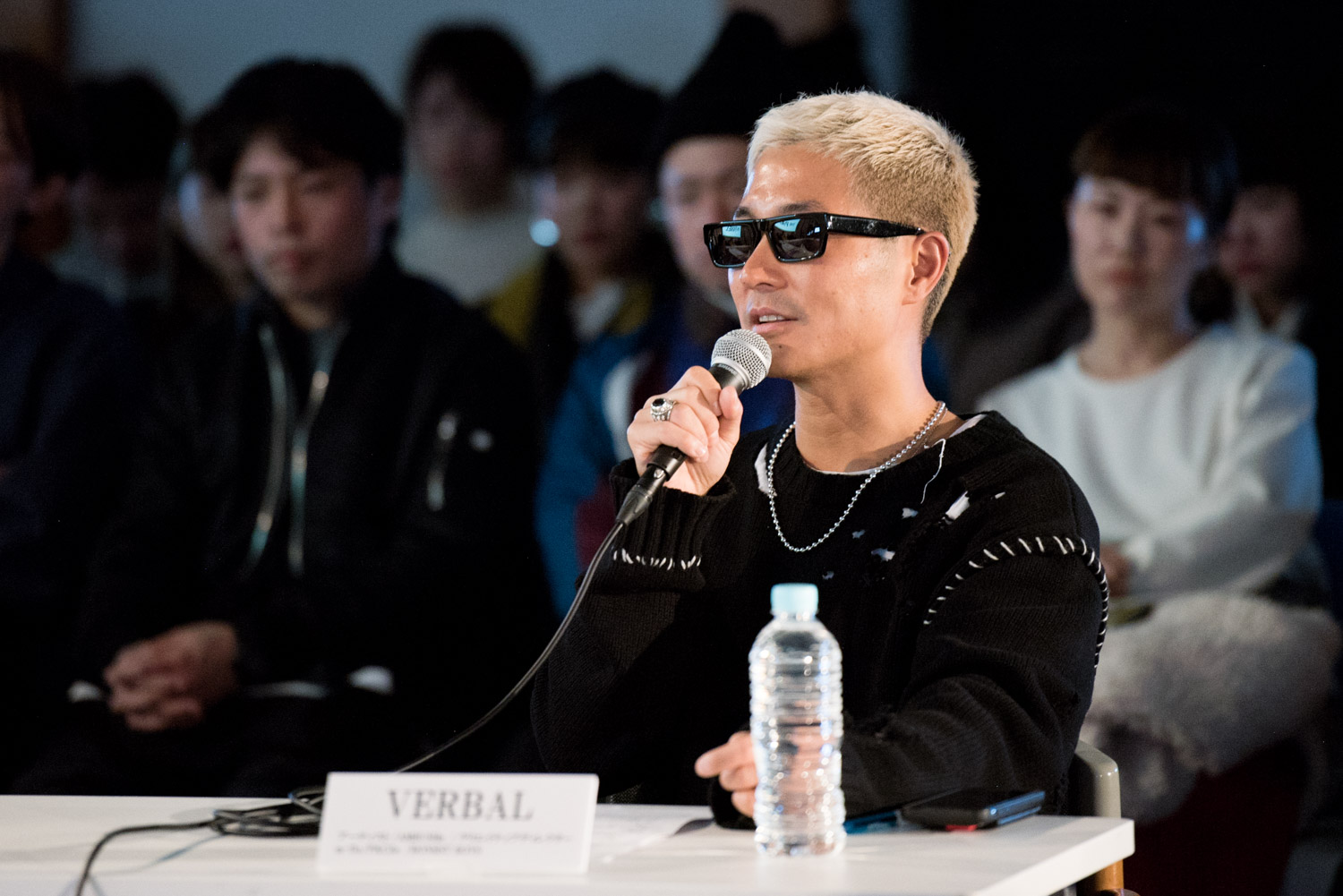
VERBAL:例えば、ずっと襟の周りが黒くならない、ケチャップをこぼしてもすぐに白くなるようなシャツはどうなんでしょう?
藤原:汚れないシャツがいいという人もいるけど、一方では汚れている古着を着たい人もいるわけじゃない? だから、テクノロジーで全てに取って代わるのではなくて、1つの要素として加わるという風に捉えたいですよね。
VERBAL:永遠に汚れないシャツを開発できたら、某紳士服屋さんとかに、オーダーいただいてビジネスになりそうですけど。
藤原:でも一回きりでしょ? 誰も買い替えないから(笑)
鈴木:汚れないけど、すぐに破れるようにすればいい(笑)
光嶋:エジソンですね。切れるように電球をデザインした…。
藤原:デザイナーとして、中里さんは汚れない生地があったら使いたい?
中里:私はあまり魅力を感じないです。ファッションでテクノロジーを用いると手段と目的が逆転してしまうように感じることが多いんです。個人的には、無意味なところで高機能みたいなほうが、クリエーションとしては面白いですね。
藤原:汚れないシャツは、ライフスタイルとして欲している人はいるかもしれませんが、僕らは、50年前の革ジャンもたまには着たいし、これから先も今作ったものを50年後に汚れた状態でも着てもらえたら嬉しい。そういうところにファンタジーを感じるのが、古いタイプなのかもしれませんが、クリエイティブ・ディレクターですよね?
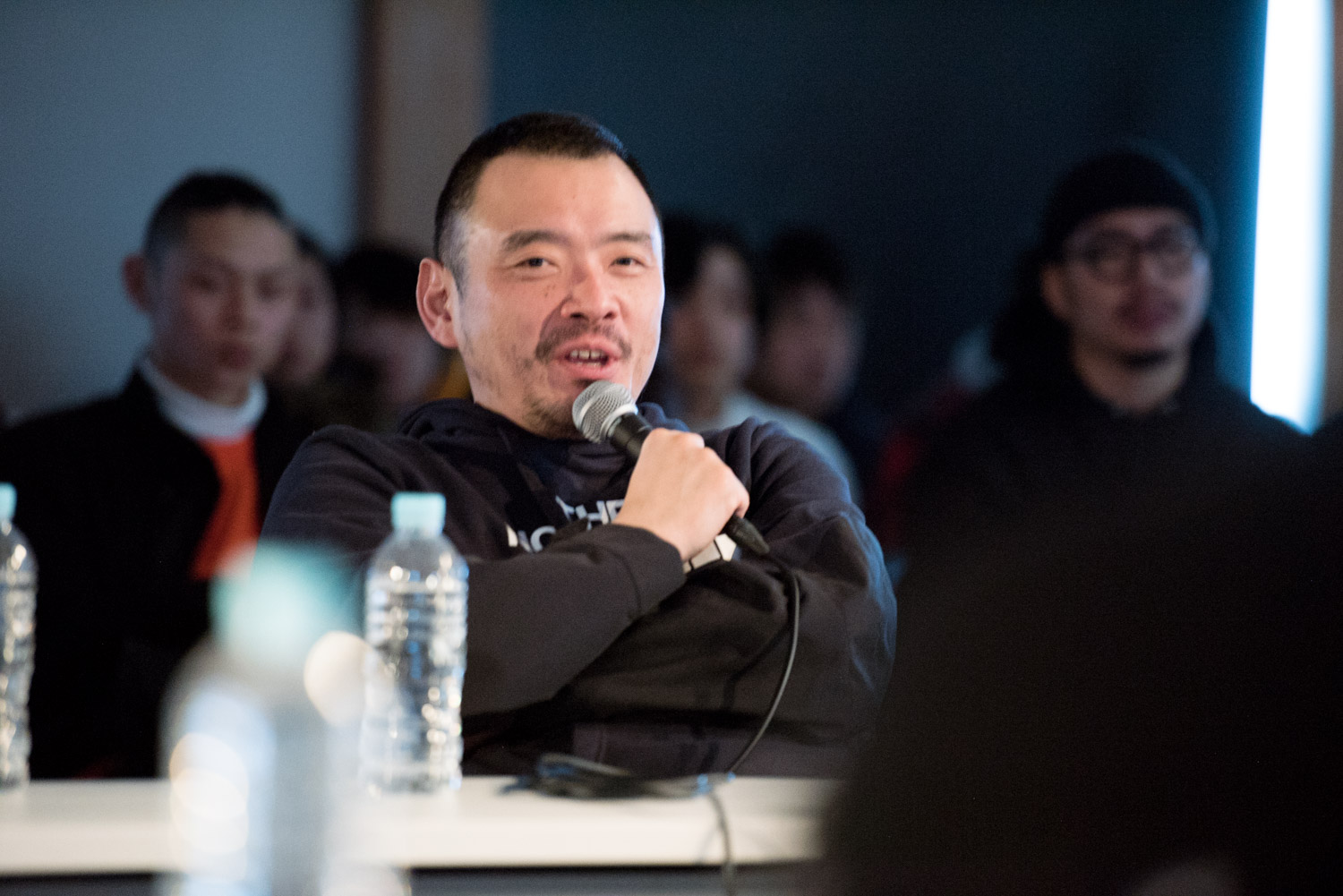
源馬:僕が(sacaiで)やっていることも、ある意味古いことです。ほとんどの方にとってパリコレなんて、どうでもいいことだと思います。でも僕はそこに死ぬほど力を注ぐし、それこそ僕たちの人生。そのファンタジーが人を幸せにすると思うと、テクノロジーとは別にやれることはある、と思うんです。
鈴木:いくら最新のテクノロジーを使っていても、そこにかっこいいとか美しいとか思わなければ、それは便利な日常品で、ファッションではないですよね。テクノロジーとファッションが共存できるポイントを理解する必要があると思うんです。クリエイティブ・ディレクターなりデザイナーが、そこをどう考えて行くのか。例えば、作る物自体はアナログだとしても、Eコマースだったり、お客さんとのコミュケーションでのテクノロジーの活用は活発になってますよね。
源馬:ファッションデザイナーの中には、新しいテクノロジーを使うことを好まない人もいるのですが、プロモーションの方法としてはデジタルを使いたいと思います。チョイスが持てる分、正しいものをチョイスしたいんです。僕らは古いことをしているとは思うけど、新しいものに拒否反応をしないようにしています。
2. 盛りすぎと軽さ
藤原:ところで僕らはテクノロジーの進化をや社会の変化を目のあたりにしてきたけど、子供のころからスマホとともに育ってきていているここにいる学生の二人にとっては、そういう感覚はあまりないのかな?
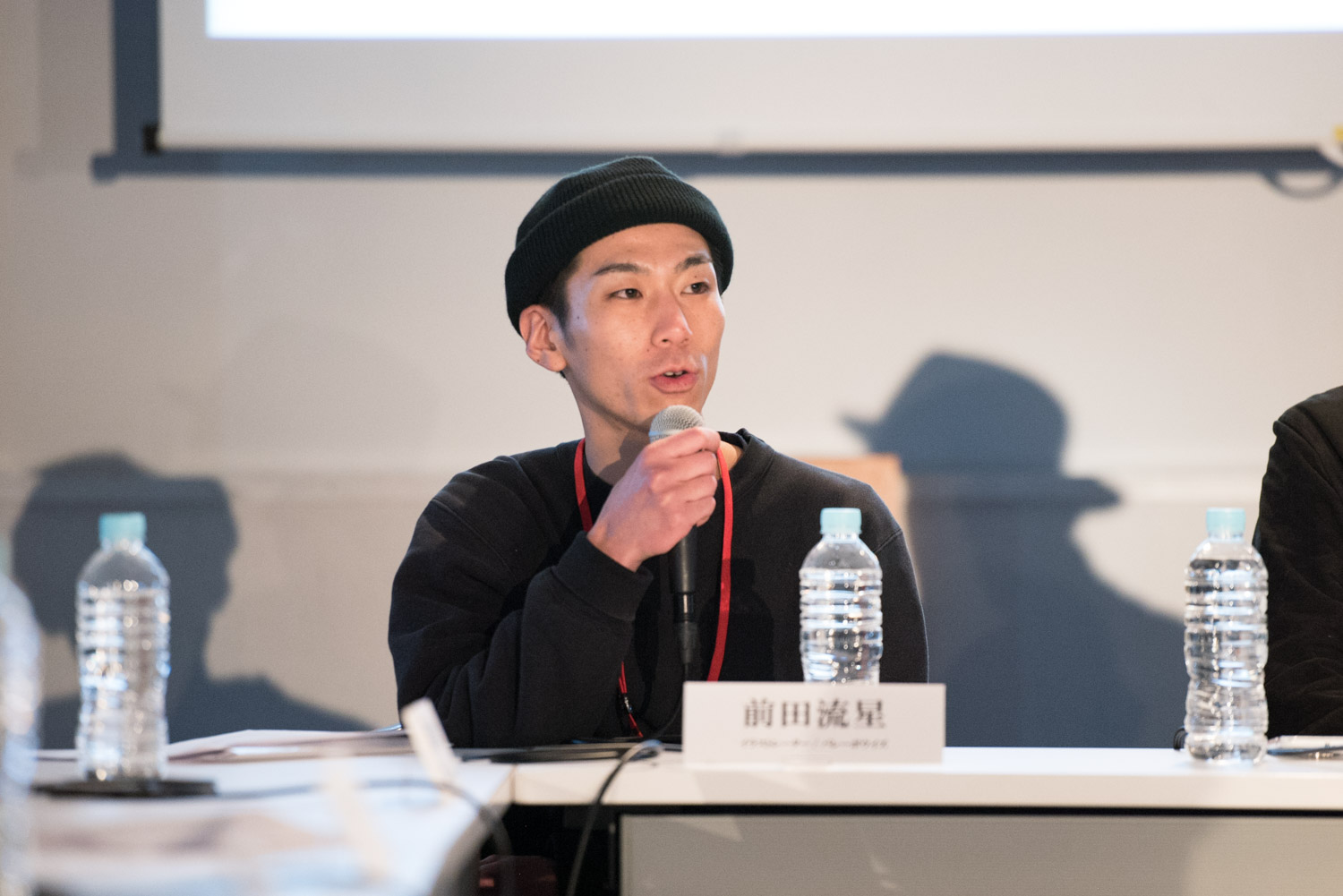
前田流星:そうですね。逆にアナログの方が新しいという感覚があります。ヒロシさんたちの世代に比べて、レコードやカセットは全然違うものに見えている気はします。
藤原:レコードしかない、ではなく。チョイスの一つにレコードがある、ということですよね。
VERBAL:昔はレコード自体に、ストーリーテリングの一環でキュレーションがあったじゃないですか。レッド・ツェッペリンのアナログ買って、ジャケ見て、実は逆再生したら悪魔の唱えている声が… みたいな都市伝説なりロマンがあって。だけど、MP3以降の世代に育った人たちは聴き方が違うだけでなく、キュレーションの仕方も、もっと多方面で高度になっていると思うんです。今なら毎日、Instagramに投稿するとかね。
前田:はい、僕もバンドをやっていますが、SNSでの発信はマストなのかなと思います。
藤原:今田さんは、例えばInstagramで洋服を見て、これを買いたい、と思ったりします? 僕らの世代は雑誌の中の一枚の写真から得られる情報量がすごく多く感じられて、写っている靴だけでなくて、背景のポスターにまで興味を引かれましたけど、そういう感覚は今でもありますか?
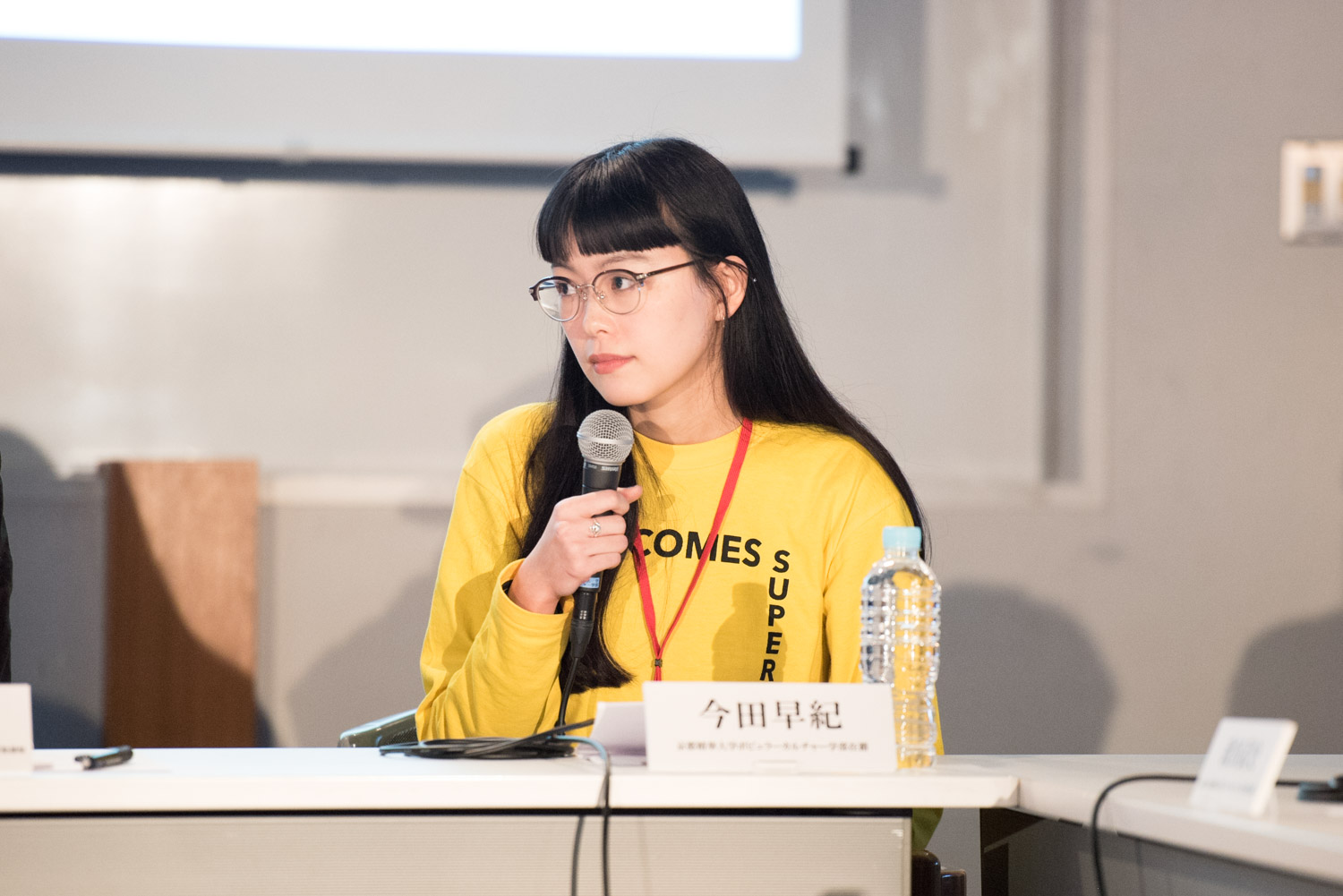
今田早紀:Instagramでは底なしに画像が見えるわけですよね。その中でピンときて数秒とどまった画像には、ほかとは違いがあるわけですけど、もしかしたら裏側はハリボテかもしれない、どこか信用できない、とも思っています。先日のMaison Margielaのショーのファーストルックが、フラッシュが焚かれるとコートの色が変わるというものだったんですが、それがすごくギャグっぽかったんです。そのライトさが私にはかっこよく見えて。SNSでは過剰に盛られる部分があると思うので、軽い方がかっこいいと感じるんです。
中里:ギャグみたいな感じは世代的な美意識なのかな。ネットカルチャーというか、そういう世代の自分たちって、Windowsのデスクトップに広がる青い空と緑の草原の薄っぺらい大自然に対して、共感が出来たりします。どこでもない匿名性や、ペラペラしているものに対するぬけ感が、逆にかわいかったり。
藤原:分かる気がします。向こうとしては本当に心を癒そうと思っていて、小馬鹿にされるためにそうしているわけではないでしょうけどね(笑)。
3.時代の潮目とストーリー
藤原:新しいものに対してオープンマインドな人もいるけど、そうではない人もいる。それを政田くんに話したときに、写真という新たなテクノロジーが登場したときの画家の話をしてくれたのが面白かったんです。
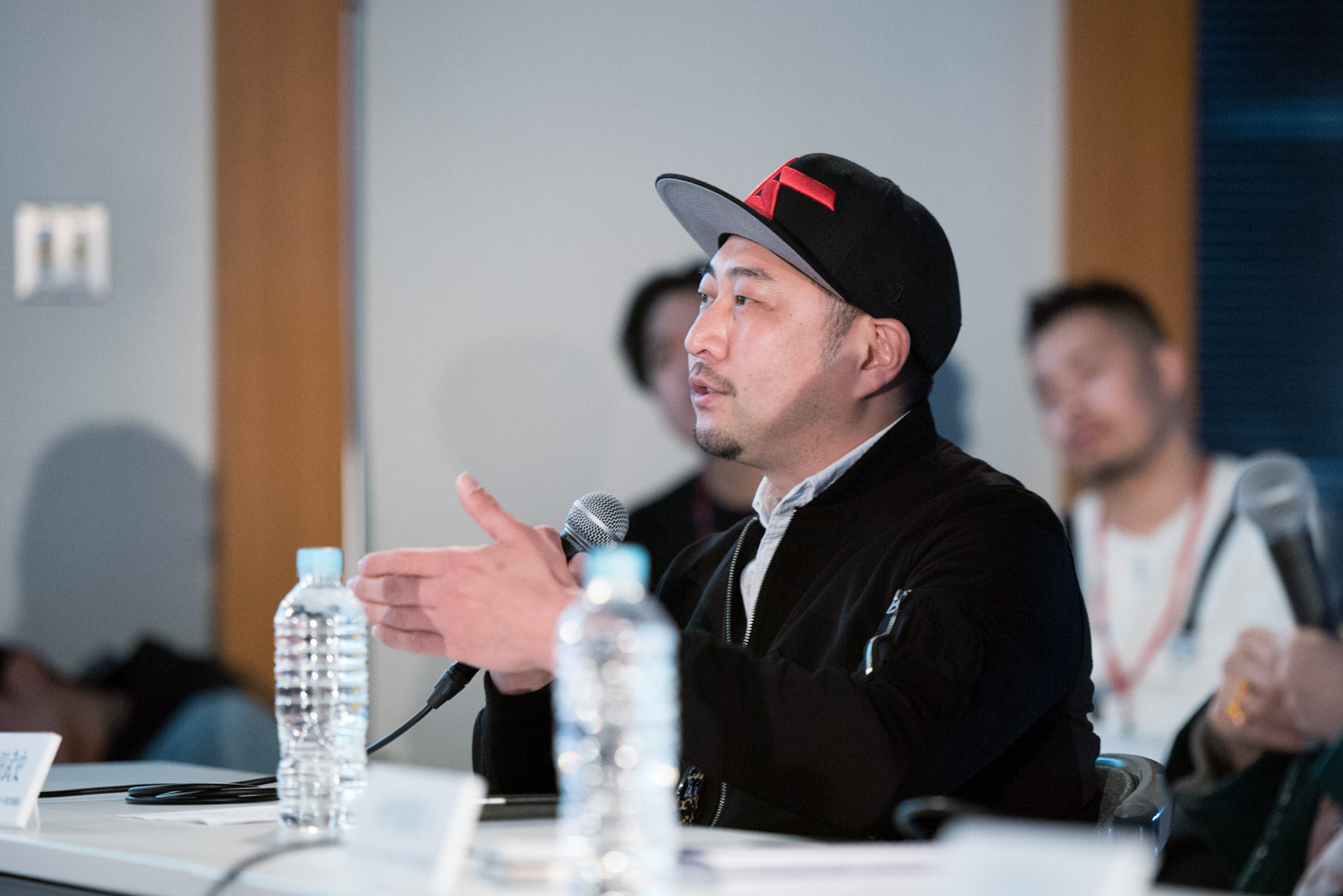
政田:中世では油絵具もテクノロジーでした。その後19世紀になって写真が生まれる。ルネサンス期にはカメラ・オブスクラ(カメラの原型となるもの。主に絵画の素描のための投影像を得るために用いられた)が開発されていたわけですけど、それを焼き付けられるメディアの発明は19世紀。そこから絵が写真に置き換えられていくんです。画家は焦り始めて、絵とはどういうものなのか問い直しはじめるわけです。そうして新古典主義に反抗するかのように印象派が始まるわけですが、あのテクスチャーだったり、もこもこした感じは、そういうことだと思うんです。僕は実物を見るまでは印象派の良さを実感できなかったんですけど、ロンドンのナショナルギャラリーではたくさん見ることができて、当時の画家の焦りというか、絵画を再発見していくエネルギーをすごく感じられたんです。
藤原:写真が出てきて焦って、おれはこう描くとか、そういう新しいテクノロジーが登場した時の切磋琢磨する感じがいいですよね。こういうことの繰り返しなのかもしれないね。
源馬:ファッションではコピーされているうちが華というか。僕らがしていることの似たようなものが10分の1で買えるなら、ファストファッションもありだと思います。いろんな志向の人がいるので、頭から否定するつもりはないですが、努力することは大切だと思います。特定の何かと戦っているわけではないけど、戦わないといけない。
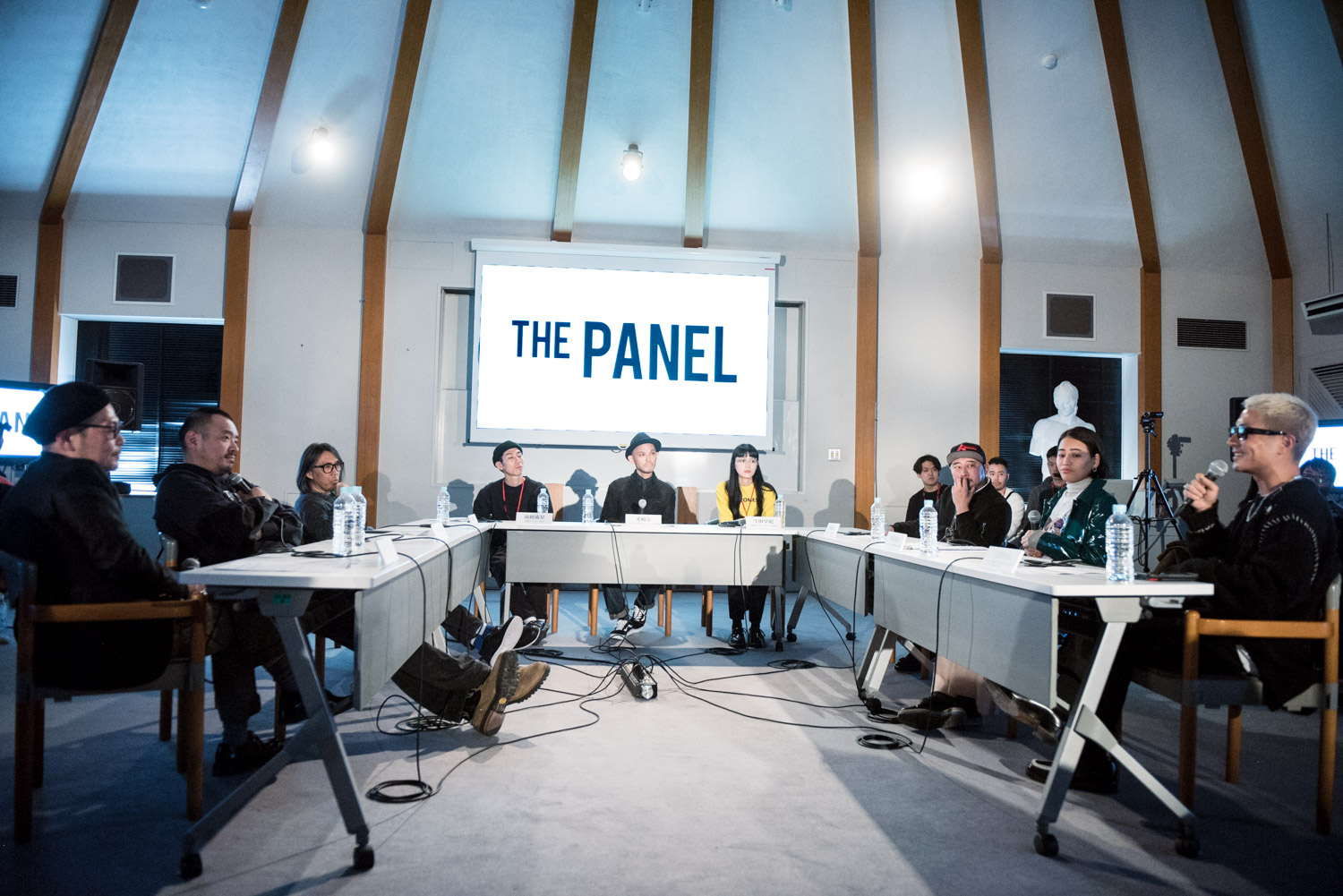
VERBAL:今は誰でも機材があれば、1~2時間でやり方を覚えられますけど、最終的にはテイストだったり、ミュージシャンの持つストーリーが差になってくると思いますね。作り方が器用だとしても、その人が最高のアーティストになるわけではない。
光嶋:そういうストーリーって当たり前だったと思うんですけど、テクノロジーの進化によってもう一度考えさせられるようになった、ということですよね。
鈴木:ブランディングがさらに大事な時代だと思うんですよ。いろいろな情報が手に入ってるけど、結局、もともと大きいブランドがさらに強くなっている。若くて新しいブランドが食い込みづらい状況になっている。大きいところは資本力だけでなくリソースも歴史もあるからさらに強くなって、安心して買えちゃう。それから、話は逸れますが、メルカリのような場でリセールの価値が落ちない、コレクターがいるなどの情報は強いですよね。
源馬:おっしゃるように、昔より若手デザイナーは世に出にくい状況なのかな、と思います。大きいところはより大きくという流れになっている一方で、洋服を着る側の個性を出してもらいたい人たちも少なからずいて。僕たちみたいに小さいことをやっていても日の目を見るチャンスはあると思います。
藤原:一見、個人がメディアで誰でも出れる可能性があるように見えるけど、逆だと。
VERBAL:Tシャツを自分で作るっていう発想がなかった時代には、誰かがTシャツにプリントを刷り始めたとき、“ええ!? 自分でTシャツ作れるの!?”みたいにすごくロマンがあったと思います。ブート感覚というか。それで、先日、Hypebeastのラジオで聴かせていただいたヒロシさんのインタビューについて話したいんですけど…
藤原:ここで話しても大丈夫なこと? 何を言ったか覚えてないんだけど(笑)
VERBAL:(笑)普段なかなか聞けない素敵なお話( sacaiとFragment Designのコラボレーション。sacai not sacai について)でした。sacaiはそもそもTシャツを作らないから、そこでTシャツを作ろう、なんならTシャツは(sacaiのものではない)ありもののボディで作って、20枚だけブート感覚で、というお話で。そんなのもうsacaiでもなんでもないし、いや、Fragmentなんですけど、そこにはストーリーがあって、かっこよさもあって、素材とかではなく、そのストーリーがブランドになっているということですよね。
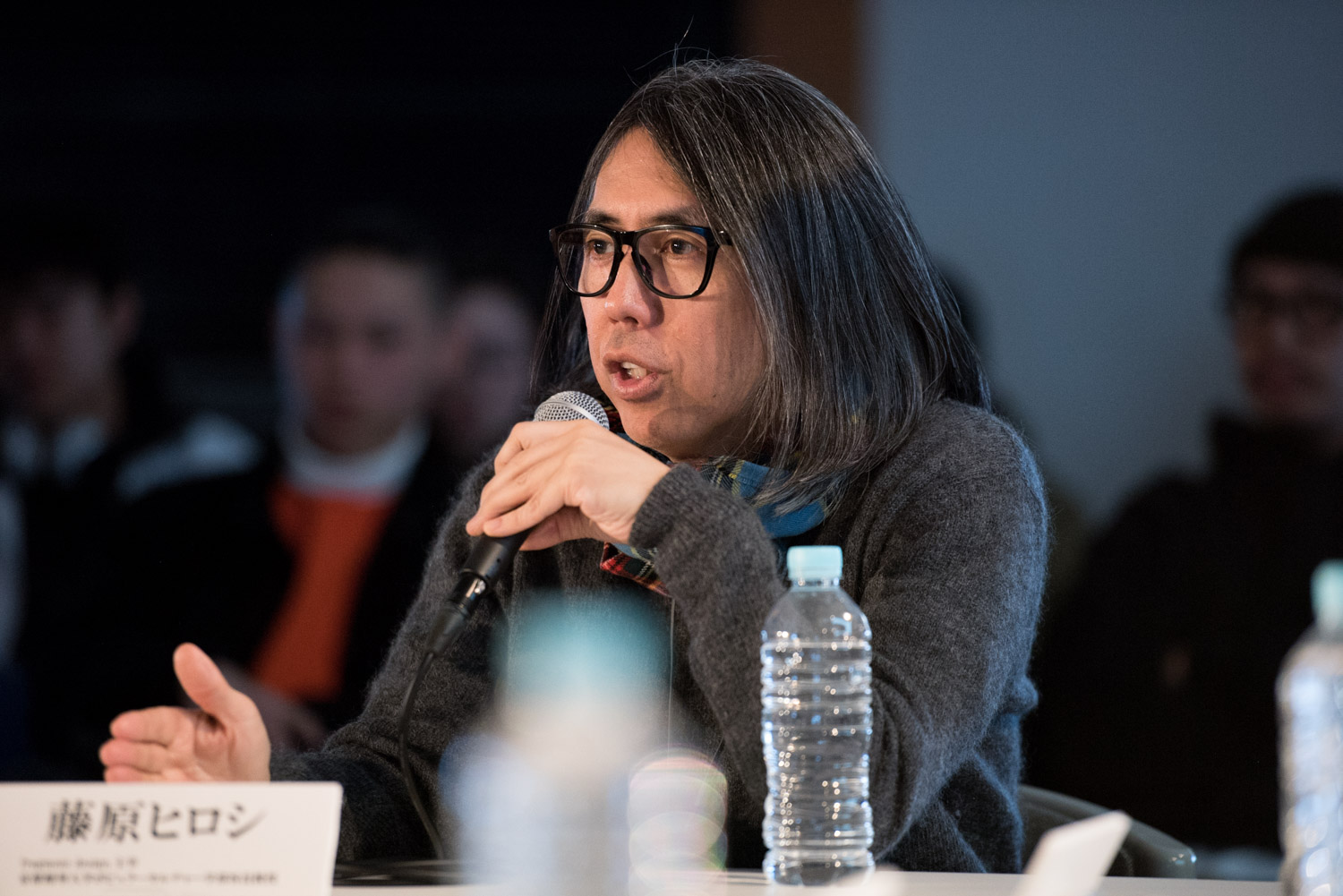
藤原:(自分たちでTシャツを作り始めた)当時はメンズビギとかのDCブランドしかなくて、自分たちで作ること自体想像できなくて、だからこそ面白いし、かっこいいと思っていました。それからしばらくした後に、visvimの中村(ヒロキ)くんは「自分で靴を作りたい」と言い出したんですよね。靴って個人で作れるのかな、なんて思っていたんですが、彼はそれを実現しました。そういう風に、インディペンデントがメジャーになることを目の当たりにしてきたのですが、今後ファッションにそういう隙間はあるのかなって思います。
源馬:間違いなく隙間自体はあると思います。それまで当たり前だったことに対してカウンターで物事進めて行くじゃないですか? そのカウンターになれるかどうか不安になるくらいに、大きいところが大きいのかも知れません。
藤原:当時、個人で靴を作って会社にするとか想像もしていなくて、今だったら個人で車作ろうかなという感じなのかな。
源馬:ヒロシさんのsacai not sacaiには、僕たちも驚きました。“作っていい? ”と聞かれたときには、(ありもののボディで)もうすでに出来ていて。“この感じ、めっちゃいい!”と思って。それまでは、どんな糸でどんなジャージを作ろうかとばかり考えていたんです。こういうストーリーが思いつけば勝てる、ストーリーを思いつく人が勝つんだ、と思いました。
4.クリエイティブと仲間
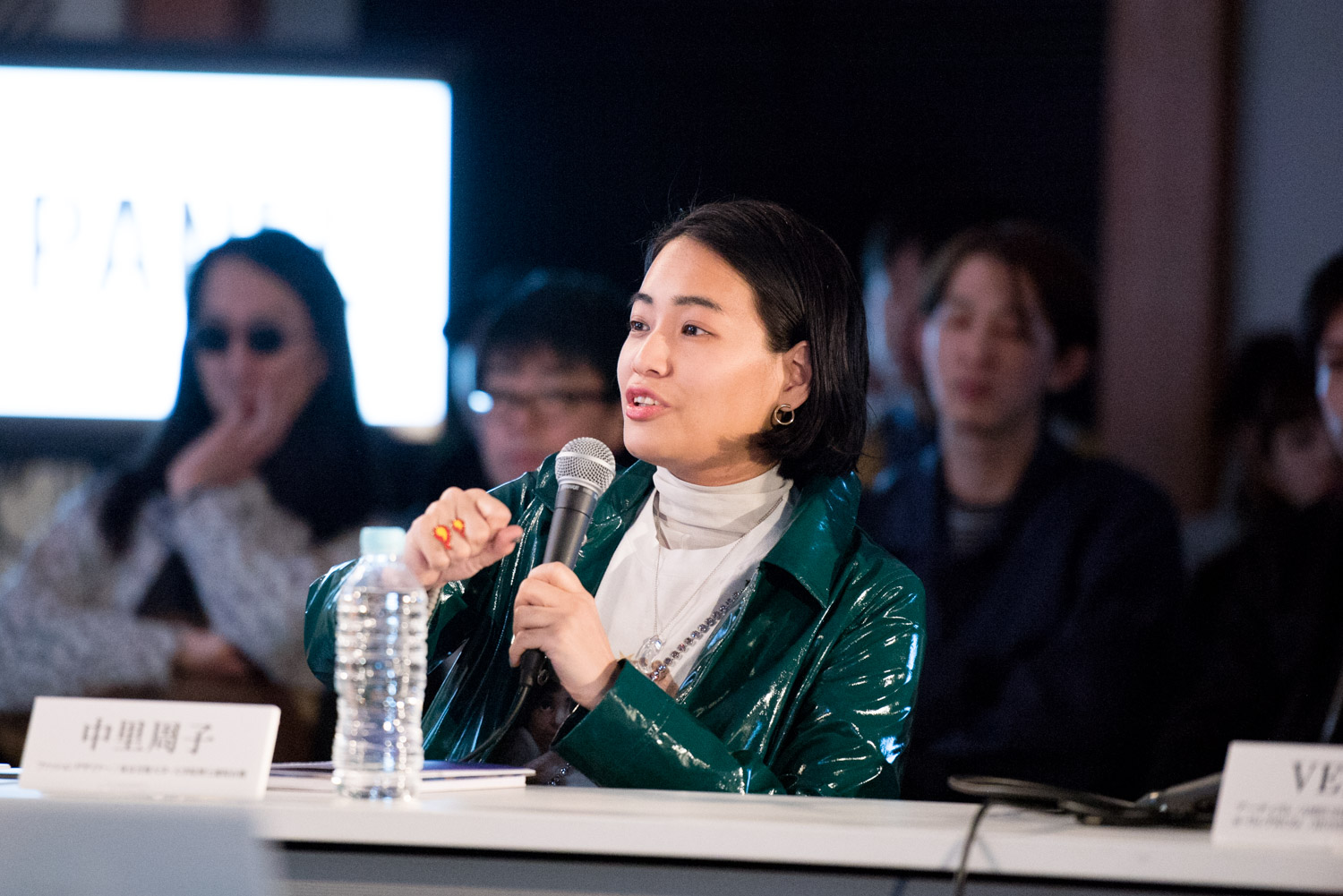
中里:若手のデザイナーがどう伸びていくのか、ということでは、世界観だけでなくブランドなりのシステムを作っていくのが大事なのかなと思っています。例えば以前私はVRを使用したコレクションの発表をしたことがあるのですが、そこでは服ではなくてコレクションの舞台となる島を船で遊覧するという発表方を取りました。その時は服を売るために、部屋を訪れた人が双眼鏡で向こうのビルを覗いて、そこで服を買えるというようなものでもいいのではないかと考えていたことが背景にあります。そういうことを考えているとどうしてもストーリーが先行しがちですが、そこをシステムとしてどう作っていくのか、というのがすごく難しいです。
鈴木:コンセプトアート寄りだけど、中里さんにとっては売るところまでデザインなんだよね。
藤原:自分で全部やっちゃいたいというか、やれるのが今の世代だよね。僕もそういう考え方だった思う。sacaiの阿部さんは同世代ではあるけど、やり方としてはデザイナーはデザインをするという役割ですよね。だからこそ、クリエイティブディレクター(として、源馬くん)が必要というか。
源馬:阿部さんは、オーナーでもあるからビジネスも全て見ているけど、基本は、デザインしたプロダクトデザインで会社を進めていくというあり方です。例えば、他の人たちがやっていないような掛け率でという売り方とか、そういうこともクリエイティブの一つとして含まれると思います。全方位的にクリエイティブでなければ、なかなか次の大きなことはできないと思います。
藤原:sacaiは役割分担がしっかりしていて、古いタイプの会社だと思う。中里さんは一人で、そういったことを考えたいタイプではないかな。
中里:いえ、チームを作ることが大切だとは感じています。たとえば好きなフォトグラファーがいて、SNSでメッセージを送ったら返事があったりということがありました。一歩外に出たら仲間が見つかるというのも体験したことで、これからは仲間集めなのかな、と思います。『ワンピース』みたいな。仲間が欲しい(笑)。
藤原:なんか意外ですね。仲間が欲しいように見えない(笑)。一人で立ち向かうタイプに見える。
鈴木:中里さんが作っているものって、商品というより、作品って感じがするからね。源馬くん的にはsacaiは商品を作っている感覚でしょ? いくらクリエイティビティが高いとしても。
源馬:そうですね。商品を作っています。川久保さん(コム・デ・ギャルソン)がおっしゃるように、ファッションはビジネスと思っています。かっこいいけど売れないていうのは、僕たちのフィロソフィーではあり得ない。
藤原:僕のイメージでは、アーティストも、デザイナーも、ミュージシャンも、仲間っていうよりは、ソロが大切で、ソロでしっかりして、はじめて仲間ができるというか。仲間よりも理解者がいたほうがいいんじゃないかなと思います。
鈴木:もしかしたら仲間の定義が違うのかな。仲間というと常に一緒に何かをやらないといけない、と思っちゃうけど、そうではなくて、このプロジェクトはこの人と、みたいな。
中里:一人でできることは限られていて、自分でできないことはできないから、開き直ることも大切だと思っています。
5. SNS以降のメデイアと編集
光嶋:ハニカムの立ち上がりの時期はブログが誕生したばかりで、テキストベースの頃だっかと思います。それが、最終的にブログはインスタグラムと競うようになった、と。鈴木さん、その辺の話を聞かせてもらえますか?
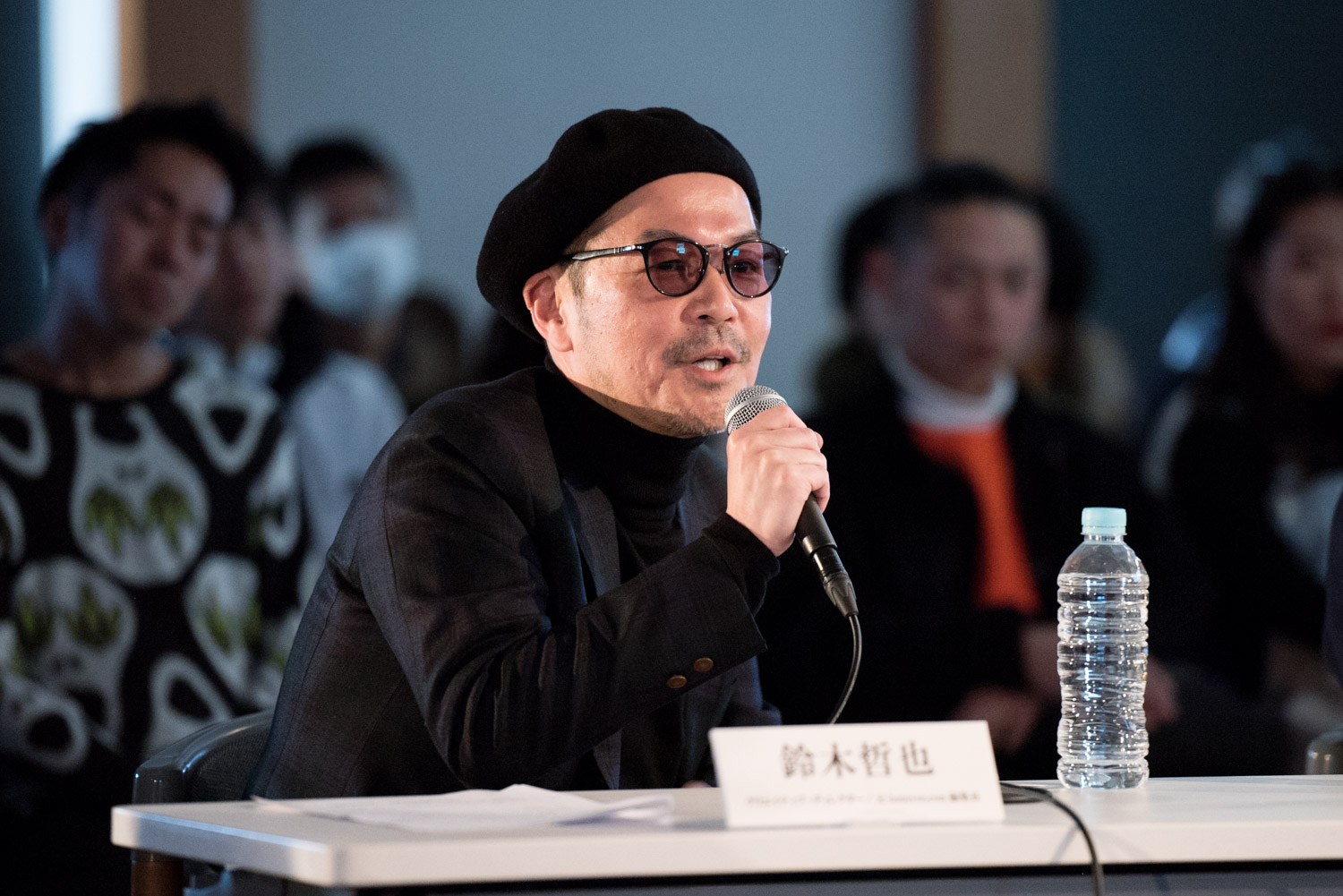
鈴木:テキストベースだったウェブの世界がヴィジュアルベースになった。そういう時期がハニカムの立ち上がりからの何年かであって、という話ですよね。かつてメディアというのは、ある種の権威だったわけじゃないですか。システム的にどういう情報を発信するかをチョイスするわけですから。でも今はその情報の流れがフラットになってしまった。Instagramは勝手にフォロワーを作れちゃって、数字として現われてしまうわけです。そういう人たちの方がリアルと言われれば、たしかにリアル。エディターが自分のフィルターでチョイスしたものが、どこか押し付けになっちゃう。いい情報持っていたり面白いと思う人をフォローします、みたいな個人間のフラットなコミュニケーションがネットのメインになったとき、編集部に情報を集めて、編集して、アップしていくことが追いつかなくなってしまった。意味のないものになってきてしまったわけです。そして、それにスポンサーも気づきはじめた。
藤原:いつも新聞からトピックをひろって授業を進めているんですが、今日の新聞には、ある大企業がSNSへの広告をやめることを検討中、という記事があったんです。テレビでは不謹慎なことがあるとスポンサーを降りるというケースがありますよね。FacebookとかInstagramには不謹慎なものが多いわけで、一流企業としてそこに広告を出していいのかという検討を始めたらしいです。
VERBAL:不謹慎なページには、広告が掲載されないアルゴリズムがあると思います。まだ痒いところに手が届いてないだけで、ユーザーのツボがわかってくれば、また状況も変わるのかなと。
藤原:そう思います。不謹慎だろうがなんだろうが、今の流れには逆らえないところもある。
鈴木:メディアは不特定多数の相手にメッセージを届けてきたけれど、今後は個々のユーザーへの最適化がなされますよね。VERBALさんにはこういう情報、中里さん向けにはこういう情報みたいな。最適化の精度はどんどん上がっていきますよね。コンテンツの作り方もそうなってくると思います
源馬:僕らのやっているデザインが編集作業というだけでなく、言ってしまえば人生はぜんぶ編集だと思うんです。広告に不謹慎なものがあるのなら、それを外す編集が必要だと思います。
藤原:みんな今日の名言控えといてね。“人生ぜんぶ編集”。そんなこと言われたら幕引きの時間じゃないかと思っちゃうけど。
6. AIには負けないクリエイティブ
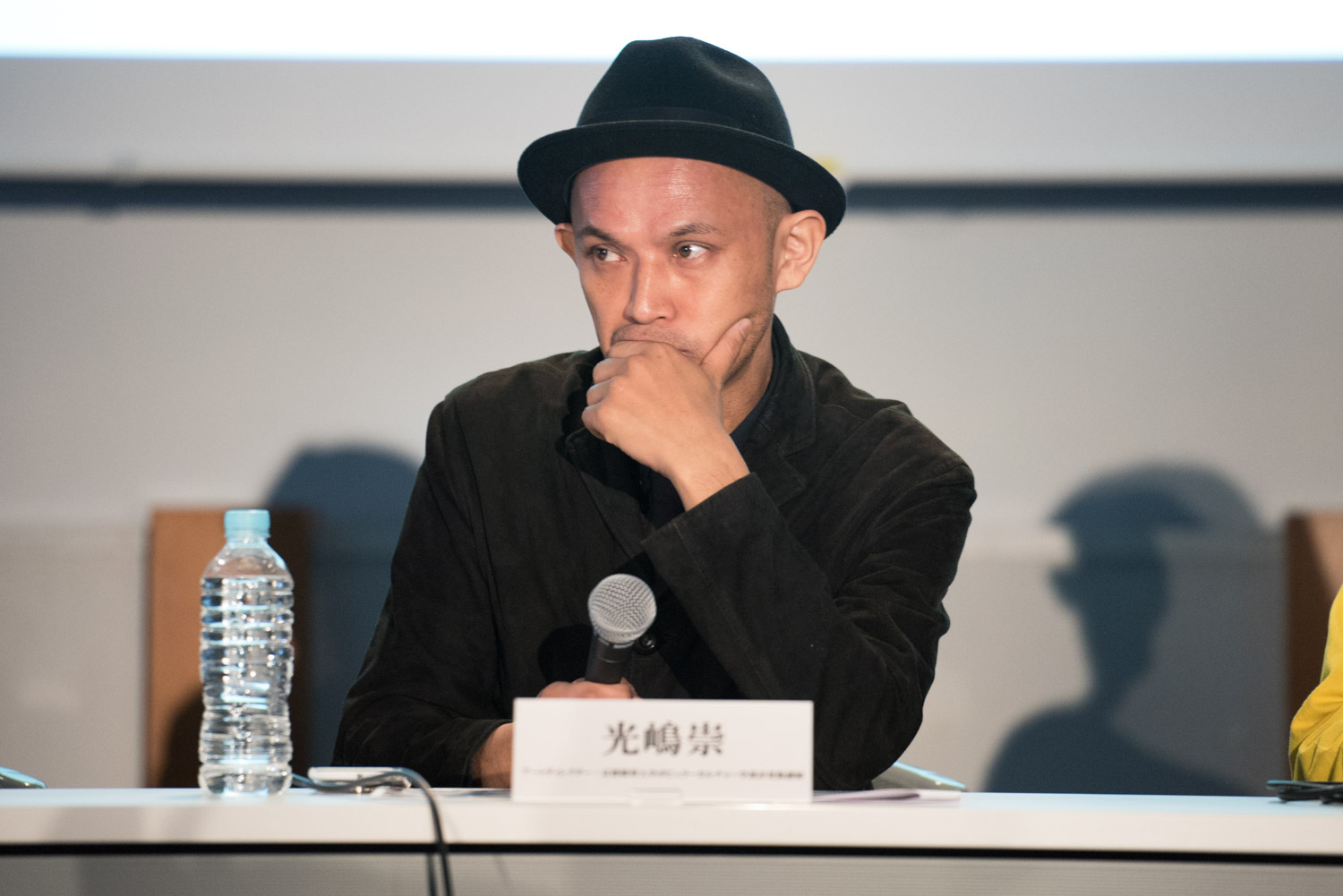
光嶋:AIが台頭してくるであろうこの先、音楽とファッションはテクノロジーと共にどうなっていくと思われますか?
VERBAL:僕は何かを作るとき、最初から最後までを見届けたい方なんですが、一人ではすべては出来ない。今後はAIが発達していくにつれ、誰にでもできそうなことはテクノロジーに任せて、クリエイティブなことだけに集中できる環境を作りたいです。レコードや古着を掘ったりしたいので、単純な作業を任せられるといいなと。
中里:AIが色々できるようになっていくとしても、最終的に、見立てということができないんじゃないか、ということを以前耳にしました。美しさについて考えたとき、(AIには評価できない)無駄なものに対するエレガンスってすごいあると思っていて。豊かさとか儚さとか、ある意味で無駄な要素をあわせた中でぬけ感みたいなものが生まれて、それがすごい大事だなという気がしています。
藤原:僕はいつになってもAIに勝てると思っていて。AIの提案に対しては、“ダサっ”と言えばそれ以上何も出来なくなると思うんです。“そんなことより、僕はここにチェーンをつけたい”っていうのがファッションでは重要だったりする。AIがどれだけ効率的に心地良い洋服を作ってきても、天邪鬼な気持が大切。
源馬:まあ、人生は編集ですし(笑)、最終的には人間がチョイスすることですから、そこさえ間違えなければいいと思います。これまでも本当にかっこいい人は少しだけだったし、僕たちはそのかっこいい人たちと一緒にかっこいいことをしたいんです。
鈴木:かっこいいとか美しいと思う気持ちが人間にある限りは、AIには負けないけれど、便利さや快適さに負けちゃうときは来るかもしれない。“ファッションなんて無駄なだけじゃん”、と言われたときに、“そんなことない”、というのが理屈では負けてしまうわけじゃないですか。だから、無駄とか便利を越えたところにあるかっこよさ、美しさ、高揚感をいろんな人にわかってもらう方法が、必要になるかもしれませんね。
藤原:僕らはマイノリティなことをファッションとして居心地よく感じているんだけど、企業はそれに期待して大きく売ろうとするじゃない。でも、それって期待しすぎじゃないかとは思うよね。大きくなるとつまらないものでもあるわけだから。少しであるべきことが、多数であるべきものと混同されている。
光嶋:「いいね」がつかないくらいが、ちょうどいい的なことですか(笑)
藤原:そう思いながらも、ちょっとは「いいね」をつけてもらいたい(笑)
光嶋:でも、めっちゃつくとそれはそれで…
藤原:“わかってないじゃん? ”みたいなところはあるよ(笑)
光嶋:ところで、ヒロシくんはスティーブ・ジョブスさんとも交流がありますよね?
藤原:2回しか会ってないけどね。
光嶋:普通は会ったことないですから。

藤原:Appleはサブカルチャー的な企業としてスタートしたけど、気がつけば、世の中の全員がiPhoneを持ってるほどポピュラーな企業になった。それでも、今も潜在意識にAppleはかっこいい、とあるのは、すごいブランディングだと思うんです。それってAppleしか成し遂げてはいない。さっき言ってた、“お前ら大きいのやっとけよ、こっちで小さいことやっとくから”というかっこよさとは全く違う。クリエイティブな仕事は、メジャーに認めてもらう必要は全くないからこそ面白いのだとしても、彼らのようになることは簡単ではない。僕は大きいものが大きく光り輝いている中で、別の仕方で輝きたいと思っています。
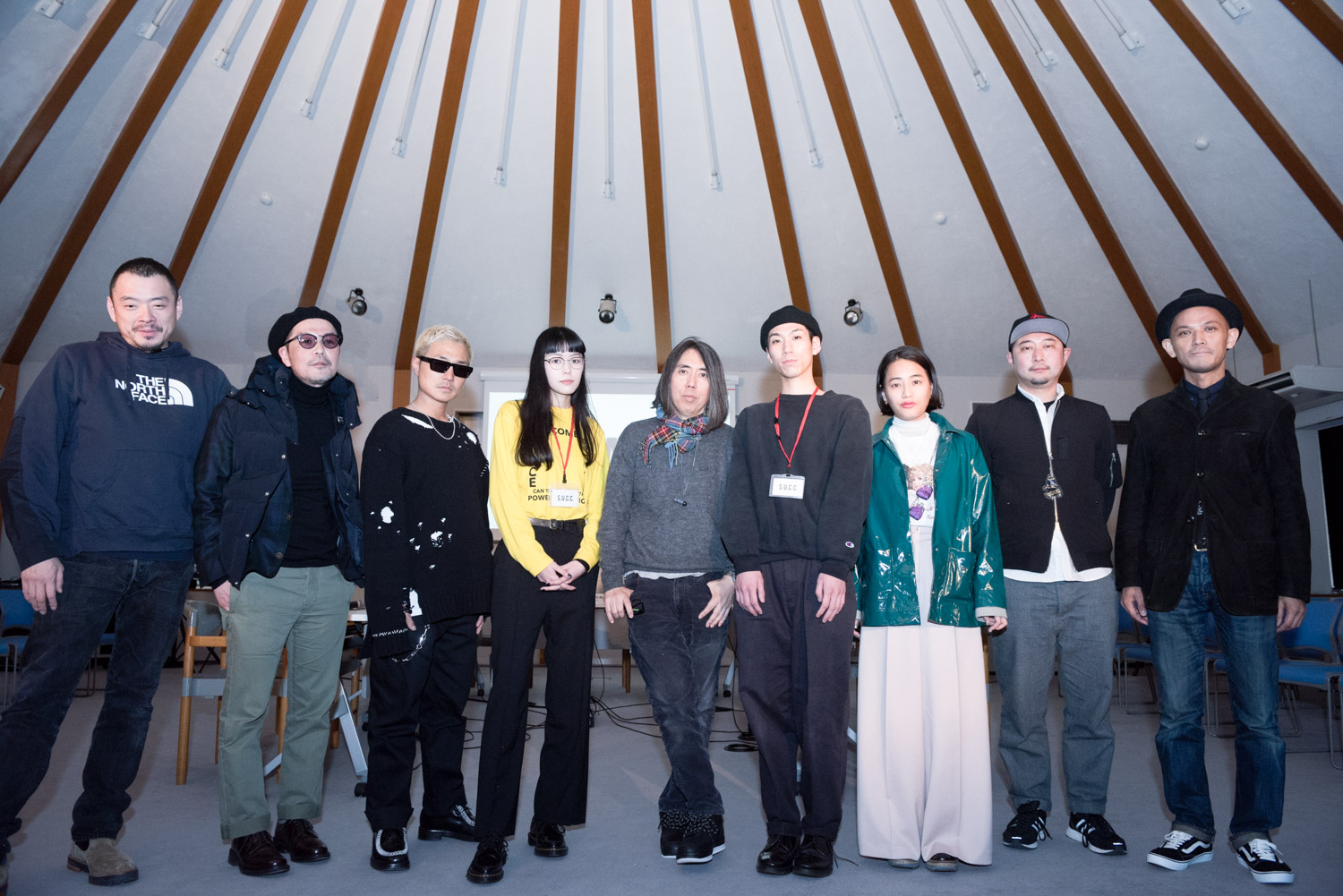
- Keywords:
- Others (Clothing)
- Others (Digital)
- Others (Life)




